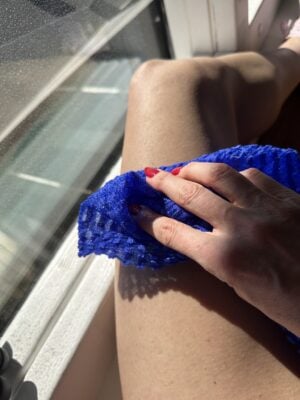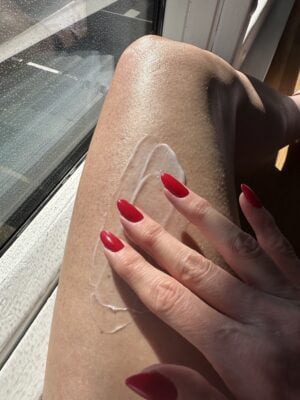When it comes to skincare, we often focus on our face—but what about the rest of our body?
Your legs deserve just as much attention, especially in the colder months, and this “leg facial” that I gave myself, truly transformed the skin dryness in just 20 minutes.
Here’s my 3-step, 20-minute leg facial that completely improved my skin’s texture and brought it back to life. From bumpy and dry, to silky smooth legs. Voila.
Why My Legs Got Really Dry and Needed a Leg Facial
As an expert esthetician, I’m all about taking good care of my skin, whether on the face or the body. However…recently I ran out of shaving cream and shaved my legs with water and ended up with a razor burn. Immediately after I got out of the shower, the skin stung on my legs and were red and irritated for hours after. Ouch.
Normally, I would cure it with a good body lotion for dry skin however, I do a workout for my body three times a week with these electrical pads for increased muscle stimulation and you can’t have body lotion the skin as the adhesive pads won’t stick. So ,I wasn’t applying much lotion and my leg showed it.
So what does an expert esthetician do best? Give a facial! I needed some serious help, so here’s what I did to get smooth legs — fast.
The Leg Facial Products
How to Get Smooth Legs with a Leg Facial – Step by Step
Step 1: Loosen up dry skin cells with a chemical exfoliant peeling pad
On dry skin, I used the DERMAdoctor KP Duty Body Peel Pads and wiped them over my legs. These powerful peel pads are specifically formulated to dissolve the rough, dry bumps and dead cells using a blend of glycolic, lactic, salicylic and lactobionic acids. It’s normal that I felt a tingling sensation. After all, the skin barrier was severely damaged and the pH of the pads range from 1.5-2.5. One pad was enough for both legs, but I worked quickly to avoid the pad from drying out.

Step 2: Buff away dry skin with a “physical” exfoliator
Next, on dry skin, I rubbed the Back & Body Buffing Towel, over my legs. This towel is fairly abrasive (which I love) so it really polishes off all of those dry, damaged skin cells. You can really feel it working. I used this for about four minutes per leg to give them a great polishing.
I didn’t apply a lot of pressure since the towel’s texture is pretty powerful so go easy – especially for your first time giving your legs a facial. I could already see the skin start looking smoother before my very eyes. So transformative!

Step 3: Continue the exfoliation with a chemical exfoliating mask
Okay, so now I used a body lotion, the DERMAdoctor KP Duty Lotion. This is a body lotion, not an actual mask. Since I had already done two steps of exfoliation, I used it as a 10-minute mask.
This lotion is super powerful (pH ranges from 3.5-4.5) and is packed with glycolic acid and lactic acid (AHA’s) along with gluconolactone and lactobionic acids (PHA’s) to really dissolve dry, bumpy skin even deeper. I massaged it into my legs and left it on for 10 minutes. It definitely stung my legs, but I am used to the feeling of using acids and I know this is what I needed to resurface the rough, bumpy texture on my legs.
After 10 minutes, I hopped into the shower and rinsed it off. My legs were definitely feeling sensitized but this is a normal sensation when doing three steps of exfoliation. After the shower, I applied my body balm to condition the skin and my skin texture was truly transformed. The results were absolutely incredible! If you have dry skin on your body, I encourage you to try this. I’m obsessed.

A few final notes about my leg facial…
- The results in the before and after photo were from just one treatment. I repeated this leg facial three days later to further resurface the skin so get even more improved results.
- For maintenance, I recommend a leg facial twice a month but you can maintain with the Back & Body Buffing Towel and the DERMAdoctor KP Lotion (used as a leave-on body lotion) at least once a week.
- Always listen to what your skin is telling you. I am well versed in what exfoliating acids can feel like but if it feels too much for your first time, then discontinue use.
- Exfoliating acids can increase your skin’s sensitivity to the sun so avoid any sun exposure for two days after doing this leg facial.
All in all, exfoliating acids can give you the glow from head-to-toe. As you can clearly see, the results were incredible! You can do this twice a month, especially during winter. Enjoy your dry legs becoming oh-so-touchable and smooth!
Note to self: I will be sure not to skip using shaving cream next time I shave to avoid having the skin on my body get this dry again!
Want to transform the texture on your face? As an expert esthetician, do this once a week to your face. Here’s how to give your skin a facial at-home
Celebrity Esthetician & Skincare Expert
As an esthetician trained in cosmetic chemistry, Renée Rouleau has spent 30 years researching skin, educating her audience, and building an award-winning line of products. Her hands-on experience as an esthetician and trusted skin care expert has created a real-world solution — products that are formulated for nine different types of skin so your face will get exactly what it needs to look and feel its best. Trusted by celebrities, editors, bloggers, and skincare obsessives around the globe, her vast real-world knowledge and constant research are why Marie Claire calls her “the most passionate skin practitioner we know.”













